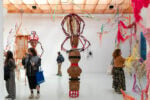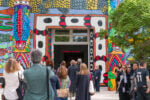Lynda Benglis – Benglis and the Baroque
.jpg)
La galleria Thomas Brambilla è orgogliosa di presentare la prima mostra personale in Italia dell’artista americana Lynda Benglis intitolata Benglis and the Baroque.
Comunicato stampa
La galleria Thomas Brambilla è orgogliosa di presentare la prima mostra personale in Italia dell’artista americana Lynda Benglis intitolata Benglis and the Baroque, la quale inaugurerà sabato 10 dicembre 2016 alle ore 18:30.
La mostra include una selezione di lavori recenti in carta e gesso, alcune ceramiche colorate e una serie di grandi Torsi marmorei, appositamente realizzati dall’artista.
Per la prima volta nella sua carriera, la Benglis ha sperimentato le proprietà di questo emblematico materiale in quattro varietà, rievocando così il legame con l’arte di Gian Lorenzo Bernini, ed in particolar modo il Monumento funebre di Papa Alessandro VII. Durante la sua carriera, l’artista aveva già stabilito alcuni evidenti parallelismi con l’opera di Bernini, come ad esempio la serie delle Pieghe, richiamanti gli svolazzanti e leggiadri drappi scultorei barocchi, nonché la monumentale fontana North, South, East, West, una versione contemporanea della Fontana dei Quattro Fiumi di Bernini.
Sebbene nell’Arte contemporanea il marmo sia utilizzato nella sua varietà bianca, come nel celebre cubo di Sol Lewitt, la serie di Torsi Benglis and the Baroque è composta da sculture colorate in cui le venature marmoree, con i loro differenti dettagli e sfumature, amplificano le capacità materiche e divengono segni biografici e simbolici. Questi nuovi lavori sono opere con un corpo fisico, catturato in un preciso gesto e momento, metaforicamente definito dall’artista “the frozen gesture”. In essi la Benglis è riuscita a dar risalto a forme sinuose e dettagli brillanti, le quali donano alle opere, quello che l’Arte Barocca prediligeva: uno straordinario “movimento d’animo”.
Nelle opere di Lynda Benglis, l’attenzione ai materiali e la costante ricerca dell’elemento “stravagante”, in pieno accordo con la poetica barocca, sono caratteristiche determinanti e fondanti, tanto da essere state ricercate e stravolte lungo tutta la sua carriera. L’artista è soprattutto nota per i suoi dipinti in cera e le sue sculture create tramite colate di lattice sul pavimento, pur avendo sperimentato un enorme quantità di materiali, dai più innovativi come la gomma, il silicone e il poliuretano, ai tradizionali, gesso, bronzo e carta.
Lynda Benglis è un artista americana con origini greche. Ѐ attualmente considerate una delle artiste donna più influenti al mondo. La sua carriera è iniziata negli anni Sessanta quando il movimento artistico predominante era il Minimalismo, caratterizzato da linee e figure geometriche e una dogmatica intransigenza. In quella comunità artistica prettamente maschile, Lynda Benglis sentì che la sua poetica, caratterizzata da opere colorate e stravaganti, non fosse valorizzata e compresa, tanto da portarla a promuovere una serie di lavori in cui satirizzava lo stereotipo della donna pin-up, fino alla celeberrima fotografia per la copertina di Artforum del 1974, dove si fece ritrarre nuda con solo un paio di occhiali da sole un enorme dildo di latex.
Lynda Benglis (1941) vive e lavora fra New York, Santa Fe e Ahmedabad, India. I lavori di Lynda Benglis sono conservati in svariate collezioni pubbliche: Guggenheim Museum; Los Angeles County Museum of Art; Museum of Modern Art, New York; The National Gallery of Victoria, Melbourne, Australia; San Francisco Museum of Modern Art; Walker Art Center, Minneapolis and the Whitney Museum of American Art, New York. Recentemente il lavoro di Lynda Benglis è stato soggetto di una retrospettiva internazionale: The Irish Museum of Modern Art, Dublin; The Van Abbemuseum, Eindhoven; Le Consortium, Dijon; Museum of Art, Rhode Island School of Design, Providence; New Museum, New York; Museum of Contemporary Art, Los Angeles, Bergen Kunsthall, Bergen.
Benglis and the Baroque
10/12/2016 - 25/02/2017
Opening: Saturday, 10th December 2016, 6.30 p.m.
Opening hours: Tuesday – Saturday, 2.00 -7.00 p.m.
Thomas Brambilla
Via Casalino 25
24121 Bergamo, Italia
Ph: +39 035 247418
www.thomasbrambilla.com
[email protected]
Thomas Brambilla Gallery is pleased to present Benglis and the Baroque, Lynda Benglis’ first solo exhibition in Italy. The show opens on Saturday, December 10th, 2016, at 6:30 p.m.
The exhibition includes a series of large scale marble Torsos specially made for this show as well as a selection of her recent paper sculptures and ceramics.
Benglis and the Baroque explores Benglis’ long-held interest in Baroque sculpture. Much like Gianlorenzo Bernini, Benglis seeks to freeze the intensity of the moment and merge beauty and sensuality in spectacular frozen gestures. Benglis’ attention to materials and ongoing research into the “extravagant” are in full agreement with Baroque poetics.
Departing from the non-traditional art materials which dominate contemporary art, Benglis’ new marble sculptures signal an engagement with art history and a continuation of her ongoing embrace of the natural qualities of her various media. These are among her first sculptures in marble and Benglis exploits the material for all of its voluptuous qualities. For instance, the surface of the white Torso calls to mind the fitful undulations of Bernini’s sculptures all the while retaining the marble’s inherent glow. This effect is amplified in other works in the series by Benglis’ use of different colored marbles. On one level, colored marble harkens back to the many ancient and Baroque architects and artists who were drawn to its inherently decorative color and pattern. Benglis goes one step further and puts the naturally rich colors of her marble forms in dialogue with the veins which trace the forms' peaks and hollows, much like the cascading lines of ink and paint which appear in Benglis’ paper sculptures. This sensuous interplay of form, color and line is likely to encourage in the viewer a “movimento d’animo” (Movement of Soul).
In her recent paper sculptures, Benglis returns to torso and totem forms, recurring shapes in her decades-long career. In these works, the play of surface against structure is key. Benglis lays handmade paper over a skeletal armature of chicken wire which is sometimes concealed, sometimes revealed. The excitement that comes from this peep-show of support and surface is heightened by sparkles, another of Benglis’ signature materials. At the most basic level, these sparkles contort the forms they cover by means of their reflection and absorption of light. For the viewer, they also add a sense of movement and theatricality very much in keeping with the spirit of Bernini’s fountains. The flicker of Benglis’ sparkles imparts the works with an ceaseless changeability.
Movement appears again in Benglis’ ceramic sculptures, this time slowed down within its earthen material. Benglis has worked in ceramic since the early nineteen nineties.
Lynda Benglis (1941) lives and works in New York, Santa Fe and Ahmedabad, India. Benglis’s work is in many public collections including: Guggenheim Museum; Los Angeles County Museum of Art; Museum of Modern Art, New York; The National Gallery of Victoria, Melbourne, Australia; San Francisco Museum of Modern Art; Walker Art Center, Minneapolis and the Whitney Museum of American Art, New York. Most recently Benglis was the subject of an international retrospective which traveled to: The Irish Museum of Modern Art, Dublin; The Van Abbemuseum, Eindhoven; Le Consortium, Dijon; Museum of Art, Rhode Island School of Design; and the New Museum, New York.



